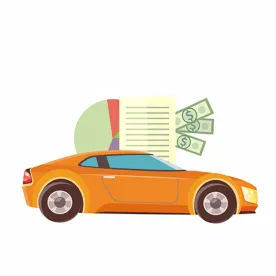One year ago, Foley launched its Coronavirus Resource Center, created by its multidisciplinary and multijurisdictional team to respond to COVID-19 in order to help clients meet the legal and business challenges that the coronavirus outbreak had created for stakeholders across a range of industries. Given that the original epicenter of the coronavirus was the important worldwide manufacturing hub of Wuhan, China, the automotive industry was swiftly and seriously impacted in ways that continue one year later. The global spread of COVID-19 has impacted the global economy and supply chains in ways not seen since the SARS outbreak in 2003.
The impact was acutely felt by automotive manufacturers, who build vehicles on a JIT (just in time) basis and depend upon a timely and uninterrupted supply of materials and components. In the case of manufacturing, it just takes one missing part to shut down a production line, and the damaging ripple effect of a material or parts shortage quickly spreads throughout the supply chain. Looking back, one year later, this article identifies five of the top impacts of COVID-19 on the automotive industry.
Raw Material Shortages
As we have covered previously, earlier declines in demand for most raw materials during the early months of the coronavirus pandemic caused many suppliers to reduce capacity. This is now resulting in higher prices and more limited supply of many raw materials, such as steel and, more recently, microchips. Many automotive suppliers and other manufacturers face complications in procuring enough raw material, including the prospect of paying higher prices, to meet customer demand. A new whitepaper from IHS Markit predicts the global microchip shortage could cut 672,000 light vehicles from production industrywide in the first quarter of 2021. Lead times for all categories of chips are currently longer by one to two months, with certain high-demand, specialized chips requiring up to 26-38 weeks, according to IHS. Indeed, reported North American production shutdowns caused by the ongoing microchip shortage have impacted multiple carmakers.
In addition to these commercial considerations, companies also must consider the impact of Section 2-615 of the Uniform Commercial Code (UCC), which defines the doctrine of “commercial impracticability” and sets forth obligations concerning allocation of limited supply. The defense of commercial impracticability is available to a supplier of goods that is unable to make delivery as required by contract, either in whole or in part in certain circumstances. Specifically, the supplier must show that delivery of all goods required under a contract has been rendered commercially impracticable “by the occurrence of a contingency or the nonoccurrence of which was a basic assumption on which the contract was made or by compliance in good faith with any applicable foreign or domestic governmental regulation.”
Courts generally apply a three-prong test to determine whether the definition of commercial impracticability under UCC 2-615 is available to a nonperforming seller: (1) the seller must not have assumed the risk of some unknown contingency; (2) the nonoccurrence of the contingency must have been a basic assumption underlying the contract; and (3) the occurrence of that contingency must have made performance commercially impracticable. For more information on this impact, click here.
Force Majeure Claims
It is quite common in supply chain contracts for the buyer and seller to have competing interests in negotiating key contractual provisions and protections. Before COVID-19, force majeure provisions were often just an afterthought in contract negotiations, with very little difference regardless of whether the manufacturing company was on the buy- or sell-side of the contract and without regard to the specifics in the supply relationship. Instead, manufacturers would copy the same, tired force majeure language across all of their contracts, which typically would be found buried at the bottom of the contract, in the “Miscellaneous” section.
In the current COVID-19 climate and, given the lessons learned as force majeure disputes continue to ricochet through supply chains across nearly every industry, force majeure provisions and related risks have a renewed focus. Going forward, manufacturing companies and their counsel will focus on mapping their supply chains and the related risks. Risks will vary, depending upon the volumes, timing of the program, the geographic location of the plant, suppliers and even sub-suppliers, whether the products are ordered on a JIT basis, whether the parts are sole-sourced or there are alternate suppliers available, and whether safety stock or inventory banks are accessible. Manufacturing companies will then use future contract negotiations and form commercial documents to allocate the various risks accordingly.
As with all divergent interests in supply chain contracts, the competing positions of the buyer and seller should be addressed during contract negotiations. For example, the party that agrees to bear risk if there is a force majeure event may leverage this risk against pricing or termination rights.
In addition to the language of the force majeure provision, there are other contract provisions that manufacturers should strengthen and best practices to implement as a result of lessons learned from COVID-19. When the pandemic began and various executive orders required manufacturers to shutter, there were a flurry of issues that impacted manufacturers. Force majeure notices were sent, but parts already were in transit—who pays for the costs to return those parts when there was no one on-site to receive them? There were situations where a plant in one location had to be closed, but other manufacturing facilities had capacity—who pays for the costs to tool up and ramp up at an alternate location or for employee overtime? Throughout the pandemic and the reopening phase, there have been additional costs incurred in manufacturing lines, including employee overtime and freight expedites—who pays? These are just some examples of the types of responsibilities and risks that can be allocated in supply contracts going forward. For more information on this impact, click here.
New Challenges Related to Warranty Claims
While nearly every facet of the economy has been affected by COVID-19, the automotive industry remains one of the sectors most affected. The industry continues to face the double impact of declining sales and increasing costs, which has resulted in financial pain for both OEMs and suppliers. As so often is the case, many automotive OEMs are seeking to offset their own declining performance on the backs of their suppliers. One tactic commonly employed by OEMs is to take a more aggressive approach in pursuing suppliers for historical, or otherwise questionable, warranty claims. Going forward, it also remains to be seen whether the scramble by OEMs and suppliers to maintain production in the face of supply chain disruptions, labor shortages, and new safety measures may result in a rise in additional warranty issues in the coming months and years.
Managing warranty claims, including both defending such claims and pursuing recovery from responsible sub-suppliers, has always been a critical task for automotive suppliers. This perhaps has never been truer than it is today. While many of the most critical issues involved in navigating a warranty claim remain unchanged, the impact of COVID-19 presents additional unique challenges and (in some cases) opportunities.
While litigation with a customer is not the preferred outcome in most disputes, suppliers should consider the impact of COVID-19 on the timing of any litigation. While courts in most jurisdictions are open and functioning, whether in person or via remote technology, many are still working through a backlog of cases and/or may not be operating at full capacity. This can add up to further delays in what often is already a long and drawn out legal process if parties are required to litigate their claims.
If an automotive OEM’s primary motivation for asserting a warranty claim appears to be based on an effort to improve financial performance, suppliers should take note of this fact. If the customer’s primary motivation is to “get cash in the door,” this can have a significant impact on negotiations. For example, the OEM may be less willing to consider accepting payment through future price reductions. On the other hand, the OEM may be more open to taking a deeper discount on the claim if paid quickly.
While always a concern, particularly in the case of older warranty claims, the impact of COVID-19 may exacerbate issues relating to the availability of witnesses and information. Any staff reductions by the supplier may result in critical witnesses no longer being available to the company or, even worse, becoming hostile to the company. Employees still with the company, but working remotely, may have more limited access to files and may be limited in their ability to conduct additional testing. For more information on this impact, click here.
Delay of Autonomous Technologies
In the months and years leading up to the COVID-19 pandemic, media outlets around the world projected the end of personal car ownership and the waning days of pizza delivery drivers. In the not-so-distant future, personal vehicles would be replaced by a fleet of self-driving cars, hailed by phone or virtual assistant. The consumer could sit in the back seat, working, sleeping, or otherwise entertaining him or herself while the car drives down the freeway at breakneck speeds. Similarly, our goods and takeout would maneuver the city in autonomous delivery trucks with drones dropping off packages and dinner at our front door without a single human interaction. That future is still possible, but the timeline appears to continuously get longer and more uncertain as the AV technology space faces development roadblocks and a black swan event no one could have reasonably predicted. The COVID-19 pandemic has not helped make the industry’s futuristic ambitions any more tangible, but those dedicated to their development continue to push ahead in spite of the challenges and uncertainty facing today’s marketplace.
Uncertain what the future would hold in the early months of the COVID-19 pandemic, companies around the globe slashed their research and development budgets, while outside funding opportunities and investors dried up, and the consumer’s willingness to buy new products and take risks on cutting-edge technologies nearly evaporated. But, once the world began to settle into the temporary new normal of COVID-19, many industry players began to realize that the implications for autonomous technologies remain more important than ever before. While budgets and investment opportunities might not be back to where they were before the pandemic hit, development projects and new partnerships have started cropping up as companies look to leverage AV technologies in a world encompassed by social distancing, a wariness for ride-sharing and public transit, and the need for reliable and uninterrupted movement of goods. In fact, a recent study by the Consumer Technology Association noted that a quarter (26%) of consumers now view autonomous delivery technologies more favorably than before the COVID-19 crisis, although it did not note the reason for such a rise in favorable sentiment. That said, a recent study conducted by Boston Consulting Group estimated the broad commercialization of AV vehicles for consumers won’t be realized until at least 2025-2026.
In our August 2020 post, The Impact of COVID-19 on Adoption of Autonomous Vehicle Technology, we noted that, while the applications for consumer products might have hit some roadblocks due to COVID-19, AV technology has numerous applications beyond the purpose of consumers commuting and getting around town. From logistics to last mile delivery, the potential applications of AV technology are further-reaching than just shuttling soccer teams and families around their communities. For more information on this impact, click here.
Matthew Sierawski also co-authored this article







 />i
/>i

